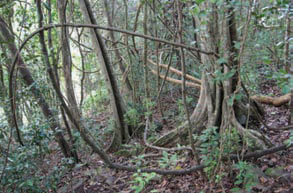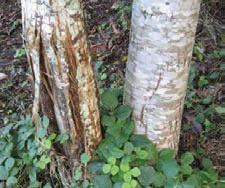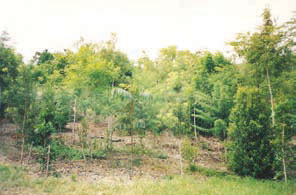Few Land for Wildlife partners in Brisbane share a history with the land as long and as rich as that of the Smith family who have owned and farmed their property at Upper Brookfield since 1914.
Just as their forebears were pioneers in working the land, Mrs Edith Smith and her son Mr John Smith are also pioneers in recognising the importance of the unique natural assets on their land and the need to protect and conserve these values for future generations. They joined Land for Wildlife in 1998 were also registered for a Nature Refuge in 2000.
Their property, 28.03 hectares in total area, is also unique and has a diversity of habitats as it spans four tall hilltops and ridgelines, has steep north and south facing slopes and a forested gully running down to a creek. The area of retained habitat covers 7.5 ha and includes a quality 5.1 ha remnant of complex Notophyll/ Microphyll closed forest dominated by Hoop Pine. This area, known as Smith’s Rainforest, is the largest remnant of this forest type left in Brisbane and an important link in a corridor along Moggill and Wonga Creeks.
Smith’s Scrub is possibly the most important hilltop of dry rainforest in the D’Aguilar Range— Dr Don Sands
Prior to the 1920s, the forest was all selectively logged, and further areas of land were cleared for farming pawpaws, bananas and other small crops. Areas of the land are still used for crop production today, along with Hoop Pine farm forestry.
John has been working hard over the years to expand the forest area and has a further 1.2 hectares under restoration.
In 2000, rainforest rehabilitation work began with 500 plants along the Smiths Lane riparian area, some supplied by a community nursery through the Moggill Creek Catchment Group. In 2001, another 2000 plants were planted in the gully in the middle of the property with a grant from the SEQ Rainforest Recovery Program. 300 more have since have been planted above the first planting area. Extremely dry conditions over the last ten years and damage from feral deer has resulted in a 50% loss rate in all but the original riparian planting.
Smiths rainforest is home to 216 species of plants, some rare and endangered. The diversity of fauna species in this area is yet to be quantified by formal scientific surveys, but preliminary surveys have found a high diversity of birds, spiders and butterflies.
Since 1985, the Pullenvale Environmental Education Centre has been bringing local primary school students groups each year to visits the Smiths, to learn about local history and the environment, and Land for Wildlife has been an important metaphor for this learning.
Drought and weeds are an ongoing challenge but with assistance from Brisbane City Council through the Land for Wildlife program, John hopes to reafforest all the degraded and non-farmed area on their land which would increase the habitat areas by a further 6.3 ha.
The Smiths are advocates for sustainable land management within the community. John believes the highly visible revegetation work near the creek is a good example to encourage more local landholders to get involved in restoration work, and is pleased to see the Land for Wildlife program expanding to assist more people in the area. John was pleased to showcase his property at the Open Property Day last September.



Article by Fflur Collier, Land for Wildlife Extension Officer, Brisbane City Council

I think I have a tiny patch of Hoop Pine dry rainforest in my suburban back yard at Seven Hills and would like some help in planting at least some native plants . where can I get Help?
Hi Tina. You may wish to check out the factsheets at https://www.lfwseq.org.au/ecosystem-factsheets/
Look at the ones under Dry Vine Forest with Hoop Pine in them. They should give you a bit of a planting guide at the back of the factsheets.
Alternatively, visit a local native plant nursery such as the Paten Park Native Nursery or Kumbartcho. They will be able to give some advice.
Hope this helps.